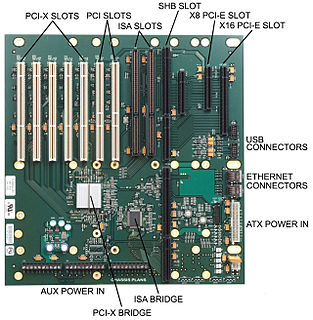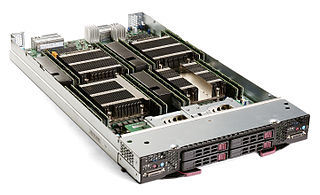Related Research Articles

A backplane is a group of electrical connectors in parallel with each other, so that each pin of each connector is linked to the same relative pin of all the other connectors, forming a computer bus. It is used as a backbone to connect several printed circuit boards together to make up a complete computer system. Backplanes commonly use a printed circuit board, but wire-wrapped backplanes have also been used in minicomputers and high-reliability applications.
RSS is a type of web feed which allows users and applications to access updates to online content in a standardized, computer-readable format. These feeds can, for example, allow a user to keep track of many different websites in a single news aggregator. The news aggregator will automatically check the RSS feed for new content, allowing the content to be automatically passed from website to website or from website to user. This passing of content is called web syndication. Websites usually use RSS feeds to publish frequently updated information, such as blog entries, news headlines, or episodes of audio and video series. RSS is also used to distribute podcasts. An RSS document includes full or summarized text, and metadata, like publishing date and author's name.

PCI Express, officially abbreviated as PCIe or PCI-e, is a high-speed serial computer expansion bus standard, designed to replace the older PCI, PCI-X and AGP bus standards. It is the common motherboard interface for personal computers' graphics cards, hard drives, SSDs, Wi-Fi and Ethernet hardware connections. PCIe has numerous improvements over the older standards, including higher maximum system bus throughput, lower I/O pin count and smaller physical footprint, better performance scaling for bus devices, a more detailed error detection and reporting mechanism, and native hot-swap functionality. More recent revisions of the PCIe standard provide hardware support for I/O virtualization.

CompactPCI is a computer bus interconnect for industrial computers, combining a Eurocard-type connector and PCI signaling and protocols. Boards are standardized to 3U or 6U sizes, and are typically interconnected via a passive backplane. The connector pin assignments are standardized by the PICMG US and PICMG Europe organizations. The connectors and the electrical rules allow for eight boards in a PCI segment. Multiple bus segments are allowed with bridges.

A blade server is a stripped-down server computer with a modular design optimized to minimize the use of physical space and energy. Blade servers have many components removed to save space, minimize power consumption and other considerations, while still having all the functional components to be considered a computer. Unlike a rack-mount server, a blade server needs a blade enclosure, which can hold multiple blade servers, providing services such as power, cooling, networking, various interconnects and management. Together, blades and the blade enclosure form a blade system. Different blade providers have differing principles regarding what to include in the blade itself, and in the blade system as a whole.
The Service Availability Forum is a consortium that develops, publishes, educates on and promotes open specifications for carrier-grade and mission-critical systems. Formed in 2001, it promotes development and deployment of commercial off-the-shelf (COTS) technology.
Advanced Telecommunications Computing Architecture is the largest specification effort in the history of the PCI Industrial Computer Manufacturers Group (PICMG), with more than 100 companies participating. Known as AdvancedTCA, the official specification designation PICMG 3.x was ratified by the PICMG organization in December 2002. AdvancedTCA is targeted primarily to requirements for "carrier grade" communications equipment, but has recently expanded its reach into more ruggedized applications geared toward the military/aerospace industries as well. This series of specifications incorporates the latest trends in high speed interconnect technologies, next-generation processors, and improved Reliability, Availability and Serviceability (RAS).
Communications servers are open, standards-based computing systems that operate as a carrier-grade common platform for a wide range of communications applications and allow equipment providers to add value at many levels of the system architecture.
COM Express(R), a computer-on-module (COM) form factor, is a highly integrated and compact PC that can be used in a design application much like an integrated circuit component. Each COM Express Module COM integrates core CPU and memory functionality, the common I/O of a PC/AT, USB, audio, graphics (PEG), and Ethernet. All I/O signals are mapped to two high density, low profile connectors on the bottom side of the module. COM Express employs a mezzanine-based approach. The COM modules plug into a baseboard that is typically customized to the application. Over time, the COM Express mezzanine modules can be upgraded to newer, backwards-compatible versions. COM Express is commonly used in Industrial, Military/Aerospace, Gaming, Medical, Transportation, IoT, and General Computing embedded applications.
The Hardware Platform Interface (HPI) is an open specification that defines an application programming interface (API) for platform management of computer systems. The API supports tasks including reading temperature or voltage sensors built into a processor, configuring hardware registers, accessing system inventory information like model numbers and serial numbers, and performing more complex activities, such as upgrading system firmware or diagnosing system failures.
CompactPCI Serial is an industrial standard for modular computer systems. It is based on the established PICMG 2.0 CompactPCI standard, which uses the parallel PCI bus for communication among a system's card components. In contrast to this, CompactPCI Serial uses only serial point-to-point connections. CompactPCI Serial was officially adopted by the PCI Industrial Computer Manufacturers Group PICMG as PICMG CPCI-S.0 CompactPCI Serial in March 2011. Its mechanical concept is based on the proven standards of IEEE 1101-1-1998 and IEEE 1101-10-1996. CompactPCI Serial includes different connectors that permit very high data rates. The new technology standard succeeding parallel CompactPCI comprises another specification called PICMG 2.30 CompactPCI PlusIO. This is why CompactPCI Serial and CompactPCI PlusIO as a whole were also called CompactPCI Plus. PICMG's first working title of CompactPCI Serial was CPLUS.0. CompactPCI Serial backplanes and chassis are developed by Schroff, Elmа, and Pixus Technologies companies, as for the CompactPCI Serial board level electronics – they are developed by MEN Mikro Elektronik, Fastwel, EKF, Emerson Embedded Computing, ADLINK, and Kontron.
PICMG 1.3 is a PICMG specification which is commonly referred to as SHB Express. SHB Express is a modernization of PICMG 1.0 single board computer specification. SHB Express, or System Host Board – Express, uses the same physical form factor as PICMG 1.0 boards. The board-to-backplane interfaces are PCI Express instead of PCI and ISA, although the use of PCI remains as an option.
PICMG 2.9 is a specification by PICMG that defines an implementation of a system management bus in a CompactPCI system. This system management bus uses an I2C hardware layer, and is based on the Intelligent Platform Management Interface (IPMI) and Intelligent Platform Management Bus (IPMB) specifications.
PICMG 1.2 is a specification by PICMG that standardizes both mechanical and electrical interfaces to support a standard form factor PCI computer system. PICMG 1.2 defines a single board computer in a passive backplane architecture with either two PCI/PCI-X busses or a single PCI/PCI-X bus. It is similar to PICMG 1.0 but removes the ISA bus.
PICMG 2.10 is a specification by PICMG that defines the use of the keying mechanisms defined in IEC 1076-4-101 for the J4/P4 connector and in IEEE 1101.10 for handle and cardguide hardware. Backplanes can be designed for 3.3V VIO or 5V VIO operation. These are differentiated by having 'Cadmium Yellow' colored keys for 3.3V or 'Brilliant Blue' color for 5V operation. If the cPCI card operates on a particular VIO voltage the card shall have the respective colored coding key. If the card is compatible with both voltages then it may not have any coding key. Other coding keys exists for use of backplanes and cards that support PICMG 2.5.
PICMG 2.15 is a specification by PICMG that defines specialized telecom interfaces for PMC cards. Later, PICMG 2.15 was revised via ECN001 to add enhanced TDM capacities by extending the TDM (H.110) bandwidth and adding Ethernet links.

M.2, formerly known as the Next Generation Form Factor (NGFF), is a specification for internally mounted computer expansion cards and associated connectors. It replaces the mSATA standard, which uses the PCI Express Mini Card physical card layout and connectors. M.2's more flexible physical specification allows different module widths and lengths, and, paired with the availability of more advanced interfacing features, makes the M.2 more suitable than mSATA for solid-state storage applications in general and particularly for the use in small devices such as ultrabooks or tablets.

SATA Express is a computer bus interface that supports both Serial ATA (SATA) and PCI Express (PCIe) storage devices, initially standardized in the SATA 3.2 specification. The SATA Express connector used on the host side is backward compatible with the standard SATA data connector, while it also provides two PCI Express lanes as a pure PCI Express connection to the storage device.
References
- ↑ "Hot Swap Infrastructure Interface". PICMG. Archived from the original on 2007-01-09.